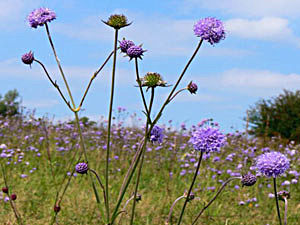
medicinal herbs
Devil's Bit Scabious
Succisa pratensis

Herb: Devil's Bit Scabious
Latin name: Succisa pratensis
Synonyms: Scabiosa succisa
Family: Dipsacaceae (Teasel Family)
Medicinal use of Devil's Bit Scabious:
The herb is anthelmintic, demulcent, depurative, slightly diaphoretic, diuretic, emmenagogue, mildly expectorant, febrifuge and stomachic. It makes a useful tea for the treatment of coughs, fevers and internal inflammations and is also a popular application externally to eczema and other cutaneous eruptions. A tincture of the plant is a gentle but reliable treatment for bruises, aiding quick re-absorption of the blood pigment. The whole herb is collected in early autumn and dried for later use. Good results have been achieved by using a distilled water from the plant as an eye lotion to treat conjunctivitis.Description of the plant:

Plant:
Perennial
Height:
40 cm(1 foot)

Flowering:
July toOctober
Habitat of the herb:
Meadows, pastures, marshes, fens and damp woods on slightly acid or calcareous soils.Edible parts of Devil's Bit Scabious:
Young shoots - raw. The tender young shoots are sometimes added to spring salads.Other uses of the herb:
A green dye is obtained from the leaves.Propagation of Devil's Bit Scabious:
Seed - sow April in a cold frame. Germination is usually rapid, but the seedlings are prone to damp off so make sure they are well ventilated. Prick them out into individual pots once they are large enough to handle and plant them out in the summer. Division in spring. Plant them straight out into their permanent positions.Cultivation of the herb:
Meadows, pastures, marshes, fens and damp woods on slightly acid or calcareous soils.Known hazards of Succisa pratensis:
None knownPlant information taken from the Plants For A Future.
